Calculating the weight of a house from aerated concrete calculator. An example of calculating a strip foundation for a house from aerated concrete according to the bearing capacity of the soil
- Date: 04/29/2015
- Views: 2883
- Comments:
- Rating: 85
- Foundation options for aerated concrete houses
- Calculation of the strip foundation for the house of aerated concrete
- Correction, check of parameters
Houses made of aerated concrete blocks today enjoy a certain popularity due to their many advantages. In order for the structure to turn out to be reliable and durable, it is necessary to correctly execute the foundation for the house from aerated concrete. There are several options: you can build a strip foundation, some varieties of columnar. Which one is better, determine the external conditions, the type of soil.
Aerated concrete is one of the most reliable and cost-effective materials for building a house. It is environmentally friendly, has good heat and sound insulation.
Foundation options for aerated concrete houses
A monolithic tape option for a house made of aerated concrete is the most optimal option. It can be placed on almost any type of soil, it perfectly dampens all seasonal deformations, distributes loads. If you don’t know which base is better to put, then stop on the tape, which is very easy to erect.
The manufacturing process includes:
- digging a trench and filling a sand-gravel mixture;
- installation of formwork, after which a reinforcing cage is needed;
- concrete pouring.
When a house with rather limited funding is being built, a solid and inexpensive pile-grillage foundation can be made.
Piles for it are laid to a depth of two and a half meters in increments of 1.5-2.5 m. From above the posts are connected using a monolithic beam, that is, a grillage, which should have a cross section of 300 by 400 mm. A correctly set foundation of this type can withstand loads even from a massive two-story house.
If in the construction of the house are used aerated concrete blocks, then you can apply and pile-plate option. In this case, asbestos-cement pipes, which are mounted to a depth of up to 2.5 m, are best used as supports. They are connected using fittings. Then the pipes are poured with concrete to form a single structure. You can use this type of foundation for a home on almost any soil, especially for complex soil types.
Back to the table of contents
Calculation of the strip foundation for the house of aerated concrete

You should consider an example of how to properly type for a house, which is composed of gas silicate blocks.
Suppose that it is planned to build a house from aerated concrete, whose overall dimensions are 9.1 × 8.8 × 6.3 meters with a roof area of \u200b\u200b123.5 sq.m. will be tape.
Construction will be carried out on clay type soil, the freezing point will be at a depth of 90 cm. Groundwater lies at a depth of about two meters. The foundation of the house will have the following parameters:
- tape width - 30 cm;
- height - 75 cm;
- length - 44.9 m;
- the area of \u200b\u200bthe base of the base is 13.47 square meters (44.9 × 0.3 \u003d 13.47).
The waterproofing layer in the form of a sheet of roofing material has a mass of 1 kg per square m. With a total coating area of \u200b\u200b13.5 square meters, it is:
123.5 × 940 × 0.0006 \u003d 69.65 kg, or 0.069 t.
Total weight for all waterproofing:
0.027 + 0.069 \u003d 0.096 t.
Double wooden windows in the amount of four pieces measuring 1.2 × 1.4 meters, three pieces of 0.6 × 1.4 meters have a mass of 650 kg (standard weight).
Thin-layer plaster in the form of a cement-sand mixture for internal and external walls has a total weight of 250 kg.
Back to the table of contents
Total weight for the house with all the loads
According to the data obtained, the total weight of the house, for the construction of which aerated concrete was used, is the sum of all the elements listed above:
33.75 + 13.2 + 11.35 + 23.9 + 1.1 + 0.561 + 0.61 + 0.28 + 0.096 + 2.4 + 0.25 + 0.65 + 0.25 \u003d 88, 4 t

Snow load is determined by reference data for your area. For example, this value is 160 kg / sq.m, in which case the loads for the roof will be:
123.5 × 160 \u003d 19760 kg,
taking into account a slope of 28 degrees and correction factors M \u003d 0.942, we obtain a value such as:
19.76 × 0.942 \u003d 18.6 t.
The payload from furniture, appliances, people will be equal to:
6439 × 180 \u003d 11682 kg, that is, approximately 11.7 tons (a value with a margin at which the area of \u200b\u200bthe house of 64.9 is multiplied by 180 kg / sq.m).
Thus, the total load indicator from the whole house is: 88.4 + 18.6 + 11.7 \u003d 118.7 tons.
The specific pressure under the sole, which has the foundation of the house, must be calculated in this way:
P \u003d 118.7 / 13.47 \u003d 8.81 t / sq.m (the total weight of the house is divided by the area for).
The specific pressure for clay soil (according to the reference data) is 10 t / sq.m, that is, this value is greater than that obtained. This means that all the calculations were performed correctly, was designed with a high level of reliability.
Currently, in a private low-rise construction, a wide variety of materials are used, each of which has its own specific advantages and disadvantages and is able to satisfy, to one degree or another, the requests and needs of the builder. A great alternative to the traditional construction of silicate or ceramic bricks is the construction of private houses from aerated concrete blocks. You can build a foundation for a house from aerated concrete with your own hands.
The ideal foundation for a house made of aerated concrete is a monolithic or monolithic-tape foundation.
Main characteristics of aerated concrete houses
The advantages of this building material can not be overestimated, given the whole range of its undeniable advantages. Here are just a few of them:
- excellent thermal insulation properties that contribute to efficient energy saving;
- the exact geometric dimensions of the blocks with minimal tolerances, allowing you to build perfectly smooth walls in a relatively short time;
- high vapor and air tightness, contributing to the creation of a comfortable microclimate in the room;
- fire resistance and environmental friendliness;
- the relatively small weight of the blocks on a certain area of \u200b\u200bthe walls and, as a result, the minimum load on the foundation.
The latter factor is one of the most important, since the minimum weight of the building material can significantly accelerate and reduce the cost of construction.
In addition, the construction bearing walls of aerated concrete blocks suggests the presence of a less massive foundation, which also significantly affects the economy. The foundation for the house of aerated concrete can be used different kinds, each of which has its advantages and disadvantages.
Back to the table of contents
Criteria for choosing the type of foundation
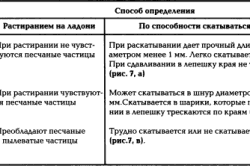
When it comes to choosing the type of foundation for a house from aerated concrete blocks, a potential developer usually comes across two directly opposite opinions on this matter. Some experts argue that due to the low weight of the blocks it is quite possible to limit themselves to a less solid foundation. Their opponents emphasize that aerated concrete blocks are very sensitive to deforming loads and, in the absence of a reliable foundation, such walls can crack. For best results, both opinions must be considered.
Another important factor that significantly affects the choice of the type of foundation of an aerated concrete house is the type of soil in the area defined for construction. The best option would be rocky or not subject to frost heaving. In this case, as a foundation for the house, a monolithic reinforced concrete slab from a height of 20 cm is quite suitable.

The most difficult soils are clay and loam. On such soils, it is preferable to use traditional, laying it to the entire depth of freezing of the soil. Often a combination of tape and plate types is used when the tape is deepened around the entire perimeter of a monolithic plate.
In addition to tape and slabs, the so-called prefabricated technology is also known, which implies the construction of a foundation from prefabricated ready-made blocks. Due to the ease of installation, this method can reduce the time for foundation work, but it is not recommended to use it for the construction of houses from aerated concrete. The fact is that such blocks have increased water absorption, and enhanced waterproofing will be required to protect the foundation from moisture. In addition, possible movements of heavy blocks are guaranteed to lead to cracks on the walls.
Back to the table of contents
Example of calculation of a monolithic strip foundation

The scheme of the monolithic foundation.
When building a house from aerated concrete with your own hands, most of the technical calculations have to be done independently. not an exception. It is very important to take this stage of work with all seriousness, since it is the foundation that will depend entirely on the reliability and durability of the structure as a whole.
Consider one of the simplified methods for a house made of aerated concrete. Suppose you want to build a one-story residential building from aerated concrete blocks with dimensions of 10 by 9 m on clay soil. As other source data, we take the following values:
- soil freezing depth - 0.8 m;
- the distance from the planning mark to the groundwater level is less than 2 m;
- the total weight of all structural elements without a foundation M1 (calculated separately) is 55.5 tons.
Based on the available data, we set the preliminary parameters of the foundation: the total length of the perimeter L, taking into account the central partition, is 47 m; width R - 0.4 m; height H - 0.8 m.
The footprint of the foundation S is determined by subtracting the area of \u200b\u200bits inside (8.2 × 9.2 \u003d 75.44 m²) from the total area of \u200b\u200bthe house (9 × 10 \u003d 90 m²) plus the area of \u200b\u200bthe central partition (0.4 × 8.2 \u003d 3.28 m²):
S \u003d 90-75.44 + 3.28 \u003d 17.84 m².
It is calculated by the formula:
V \u003d S × H \u003d 17.84 × 0.8 \u003d 14.272 m³.
As a material for pouring, we select concrete of a grade not lower than M150. The specific gravity of concrete of this brand according to the standards is 2500 kg / m³, therefore, the total weight of the foundation will be:
M2 \u003d 14.272 × 2500 \u003d 35.680 kg, or 35.68 t.
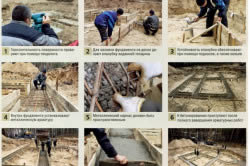
Thus, the weight of the house along with the foundation will be equal to:
M \u003d M1 + M2 \u003d 55.5 + 35.68 \u003d 91180 kg or 91.18 t.
To this value it is necessary to add the payload from the furniture, equipment, people, etc. located in the house. With a margin, this value is taken equal to the entire area of \u200b\u200bthe house, multiplied by 180 kg / m²:
M (heat.) \u003d 90 × 180 \u003d 16,200 kg, or 16.2 t.
Total total weight of the building with all the loads will be:
M (total) \u003d M + M (heat) \u003d 91.18 + 16.2 \u003d 107.38 t.
Next, you need to check the selected performance. To do this, compare the value of the specific pressure on the soil under the base of the foundation P with the calculated soil resistance R (in tons per square meter). For this, the total weight of the building is divided by the sole area:
P \u003d M (total) / S \u003d 107.38 / 17.84 \u003d 6.019 t / m².
The value of soil resistance R for clay soils is 10.0 t / m². To ensure the margin of safety of the foundation, it is necessary that the value of R is 15-20% higher than the value of P. After performing the necessary calculations, we find that the ratio of P: R in this case is 7.22: 10.0. It follows that the resistance of the soil significantly exceeds the load acting on it. Consequently, the most important condition for the reliable operation of the foundation is met and its dimensions were initially chosen correctly.
Back to the table of contents
Slab foundation calculation
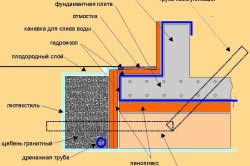
On problematic soils with a heterogeneous soil structure, it is advisable to use a slab foundation. This type of foundation can be either monolithic or consisting of separate prefabricated reinforced concrete slabs.
If in doubt, which is better to choose a foundation, then a sure-fire option will be the choice in favor of a monolithic slab foundation of shallow laying. It is a solid reinforced concrete slab placed on a substrate of bulk materials. Such a plate is “floating”, that is, it rises and falls simultaneously with seasonal movements of the soil. The main advantages of this type of foundation:
- ease of manufacture and relatively low cost;
- excellent indicators of strength and bearing capacity;
- the ability to place on absolutely any type of soil;
- frost resistance and increased thermal insulation properties;
- the possibility of using as a floor for a basement or basement.
What foundation is needed for a house made of aerated concrete? The only correct answer does not exist. Almost any of the possible ones will be a great start for the presented type of construction. It is worth noting that the construction of the base for a wooden or brick building is quickly selected, however, for new materials there are standards and requirements.
Attention! The design of the foundation for a house made of aerated concrete requires deep understanding and knowledge of some tricks that will help speed up the pouring process and create a structure that can withstand almost any load.
When designing a foundation for a house, many make a fatal mistake - reckoning that for a light material, a massive foundation is not required. The strip foundation for the house made of aerated concrete should have a calculated strength and depth, otherwise soon, the construction of the house will crack. The main objective of the concrete substrate during construction is to create conditions under which the entire pressure force will diverge evenly without peak areas.
Strip foundation under the house of aerated concrete
The main problem when constructing the construction of supports for a house from aerated concrete is buoyancy. It is this force that is balanced by buildings that are built from heavier materials. To solve the problem, you need to understand what width will be ideal. Concrete under cottage from aerated concrete can be shallow, but it is worth paying great attention to how it will be designed.
Important! With a shallow form of the base, it is necessary to use a sand pillow. It is such a pillow that contributes to better stability of the foundation, even with deep freezing of the soil.
It is worth noting that the most suitable option is the pile construction of the support for the house from aerated concrete as in the video:
The presented form of the foundation of the house due to additional piles is able to keep the foundation of the building from virtually any soil or ground from deformation. Thanks to the piles, the recess of which, as a rule, reaches 1 meter, they give the load to the soil, and counteract the buoyancy forces.
Foundation for a two-story aerated concrete house
In order to construct a foundation with your own hands for a house from aerated concrete on two floors, it is necessary to take into account all the important aspects of the construction. Among everything, the main ones are:
- wall mass and pressure force per linear meter of aerated concrete base;
- mass of ceilings that will put additional pressure on the base of the building;
- roof mass as additional mass.
When constructing a two-story house, the important question remains - what size of the foundation for the house is made of lightweight material. Professional builders who are engaged in the construction of such buildings recommend using a structure that will be at least 10 centimeters wider than the building block on top and 15-20 wider in its lower part. It is such a wedge-shaped design that will maximally prevent the "moving out" of the house on the ground. Also, when using such a base, it is worth paying attention to the substrate, which, as a rule, It is made exclusively of sand.
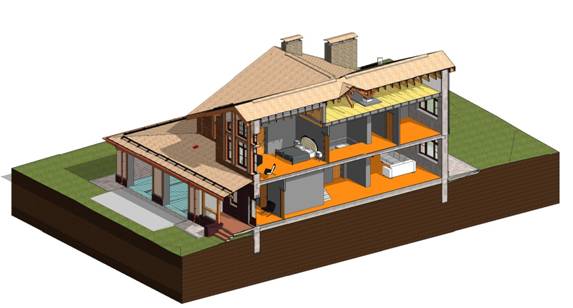
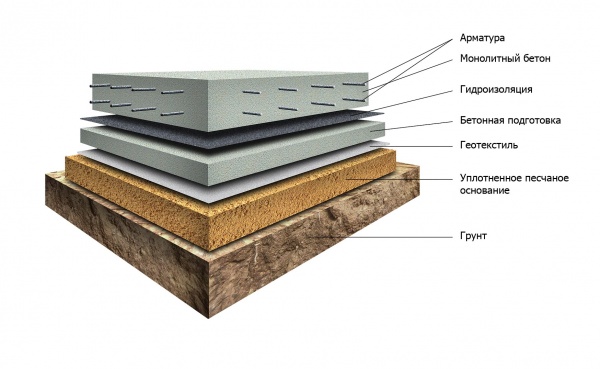
In general, the calculation of the basis for the house of aerated concrete can be carried out using an ordinary calculator for calculating the tape base for construction.
Foundation slab under the house of aerated concrete
This type of foundation is characterized by the fact that concrete is poured directly under the entire surface of the structure. There are some pros and cons when using such a construction base. Among the positive, we can distinguish:
- simplicity of pouring concrete mixture immediately at the construction site;
- use less reinforcement to strengthen the foundation;
- the foundation itself, if desired, can serve as an excellent floor inside the built house;
- the distribution of the mass of the whole house on the stove reduces the buoyancy force acting on the house.
Among the negative aspects, the use of this type of base, it can be noted:
- high costs of concrete for the preparation of concrete mix;
- the need to align the larger surface horizontally, which is possible only with the help of special equipment;
- to fill such a foundation, you need to choose a flat area or produce a large number earthworks alignment of the site for filling;
- this type of foundation requires lengthy miscalculations for water, gas and utilization fittings;
- the need for careful selection of soil to accommodate such a base structure;
- prolonged drying of the surface with a monolithic form of pouring will not allow the construction to be carried out immediately after organizational work.
Attention: like the tape structure, the presented view can “lean” on piles, which will increase the allowable load directly on the foundation.
Much attention should be paid directly to the characteristics of the soil under the future construction. The disadvantages of choosing such a foundation include a shallow bedding: at the same time, high-rise buildings without additional fortifications may “float” after some time due to washing out of the soil. Also, the presented type of foundation pouring is not suitable for those regions where the depth of freezing is higher than the mark of 1 m.
Aerated concrete is very widely used for the construction of buildings and structures. This material quickly gained popularity due to its low price, low weight, ease of construction and low thermal conductivity, which means that the house will be warm.
The light weight of the material will help to save on the foundation, good insulation saves money on wall insulation, so the real savings increase compared to the nominal.
But such material is fragile, does not work well in bending. Therefore, it is necessary to choose a foundation that will take into account all the shortcomings, as well as at least partially level them.
Types of foundations that are used for the construction of buildings from gas blocks:
- tape;
- columnar;
- monolithic;
- reinforced concrete slab.
In order to determine the type of foundation, it is necessary to calculate the load, find out the characteristics of the soil, the depth of freezing of the soil in this region, and establish the seismic situation in the zone of construction work.
To correctly calculate the foundation, you will need the help of a qualified specialist. The online calculator, presented below, will help determine the needs for materials even for those who are poorly versed in construction.
The strip foundation is reinforced concrete structure in the form of a tape with a closed loop. It is arranged under the bearing walls of the building. This foundation for a house from aerated concrete is best suited, and it is he who is most often used.
Tape Base Sequence
- The axes are split.
- Digging a trench of the necessary depth. Aerated concrete is a lightweight material and you can save money, but you need to consider the depth of freezing of the soil. How deep the trench will be - the calculation will determine.
- A sand cushion is made in the trench, then backfilling of the drainage material is performed.
- Installation of formwork, it is better to use panel formwork.
- A reinforcing cage is placed in the formwork.
- It is poured with concrete mortar with parallel compaction with a vibrator.
If not very large loads on the base, and the soil is strong enough and not loose, then the foundation for the house of aerated concrete can be installed columnar. This type of foundation is very economical.
Poles are installed only at the corners of the structure, at the intersection of load-bearing walls and in places of increased load. What the pitch of the pillars will be depends on the construction of the structure, but not wider than 2.5 meters.
Necessary tools and materials
Column Base Mounting Technology
- Markup is in progress. Pegs are installed on it.
- Wells of the required depth are breaking out.
- Pillars are mounted. They can be brick or reinforced concrete. If the load is low, then piles of metal pipes may come up.
- The tops of the posts will be joined by a grillage.
The most reliable foundation for a house made of aerated concrete is monolithic. Aerated concrete is brittle and does not work well in bending, therefore, in case of soil subsidence, the structure can crack and the integrity of the structure can be violated.
Such a basis is established in the case of:
- high occurrence of groundwater;
- the presence of unreliable soils subject to landslides or subsidence;
- construction in the seismic active zone;
- uneven terrain.
Installation technology of a monolithic base
- Site markup is in progress.
- Digging pit.
- Formwork is installed. The load on it will be serious, so it is necessary to securely fasten the walls of the structure.
- A reinforcing mesh of 12 mm rods is laid. It fits directly at the installation site.
- Concrete mixture is poured in separate layers, while being immediately compacted with vibrators.
- After the solidification of concrete, the formwork is removed, and then proceed to the construction of walls or columns.
- This foundation requires significant financial injections, but it will forever protect against problems associated with adverse effects during the operation of the building, as This is the strongest and most reliable foundation.
Reinforced concrete slab. Such a foundation for a house made of aerated concrete is also very reliable. This plate is arranged over the entire area of \u200b\u200bthe building. Based on the calculations, the optimal height of the plate is 400 mm. Its underground part is 100 mm, and the aboveground part is 300 mm.
With this design of the base there is no need to lay it to the depth of freezing, because frost is not afraid of him. In case of soil displacement, the foundation slab together with the building that is built on it will be displaced. Therefore, she will not suffer any destruction.
Due to the large footprint of the foundation, the specific load on the surface is minimized.
Reinforced concrete slab technology
- Excavation work is being carried out.
- Mounted formwork.
- The bottom of the pit is rammed, then a pillow is arranged, after which two-layer waterproofing is performed.
- Reinforcing meshes and frames fit in place.
- Using a concrete pump, a concrete mortar is supplied in small layers of 150 mm, and immediately compacted with vibrators.
- After sufficient hydration of the reinforced concrete, the formwork is removed, after which subsequent work is performed.
Possible mistakes
During the construction process, it is important to avoid mistakes that can lead to the destruction of the structure. Sometimes the dimensions of the structure, or the parameters of the cross-section of the elements are specially changed in order to save. But this is fraught with consequences.
The main mistakes made by builders:
- error of the depth of the base;
- incorrect calculation of parameters;
- wrong choice of reinforcement or violations in the manufacture of reinforcing products;
- an error when choosing a brand of solution;
- wrong choice of foundation is the main mistake.
There are many factors to consider. Initially, it is necessary to pay attention to the characteristics of the soil. If the soil is reliable, you can use a more economical type of foundation. If the soil is unstable, it will be necessary to erect a more solid supporting structure. Unreliable soil leads to deformation of the base.
What can be the deformation:
- the shift occurs in the presence of loose soils, when one side sags;
- bending is the most common deformation. May occur in case of uneven shrinkage;
- tilt can occur during the construction of a building of high floors;
- herecos occurs if the house sags unevenly;
- horizontal displacement, most commonly found in basement walls.
In order to decide on supporting structure you need to study their types and characteristics; establish the reliability of the soil, as well as correctly perform all calculations. Having provided all the nuances, you can choose a foundation that will be reliable enough, while not overpaying.
The foundation is one of the main structures. He perceives the load from the entire building, then transfers it to the ground. Therefore, it is important to choose the right foundation for such a modern and popular type of construction as a house made of aerated concrete.
Monolithic slab foundations can be found not only in private, but also in economic construction. Monolithic slabs are able to withstand heavy loads, the mass of the constructed building is evenly distributed between the slab and the ground, so there is no subsidence factor in such bases.
They can be of various designs, installation depths and types, but as a whole, consist of concrete and a reinforcing belt. In addition, a sand and gravel cushion and waterproofing are used, but these are already related materials and they do not affect the thickness of the plate itself. Often used as a base for aerated concrete and brick buildings.
What parameters affect the calculation of the slab
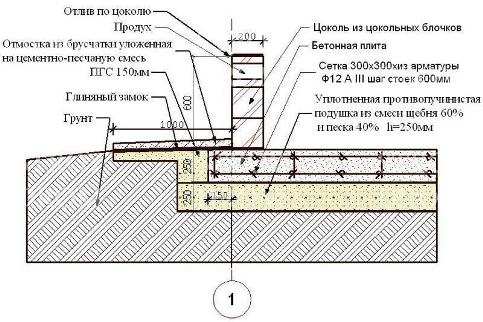
Any calculation of the slab for a monolithic foundation must begin directly with the preparation of a preliminary design of the future home. Also, a number of key parameters are initially taken into account, without which it is impossible to correctly calculate the thickness of the base:
- material of the future building, it can be wood, brick or aerated concrete;
- distance between reinforcing layers. This is a calculated parameter, it depends on the depth of groundwater, the structure of the soil and the method of making the slab;
- estimated thickness of concrete. It must be remembered that concrete must completely close the reinforcement on all planes, without exception, it is desirable to give a reserve thickness of the formwork of at least 5-7 cm;
- thickness, type and size of reinforcing mesh.
Generally for soft and light building materials, such as aerated concrete, it’s enough to summarize all these indicators and then you get the thickness of the plate. The optimal thickness is 20–30 cm, but the final result is also determined by the composition of the soil and the uniformity of all ground rocks. Sometimes a layered summation parameter is also added to such indicators if the soils are heterogeneous.
In addition to the dimensions of the slab base itself, there is also the thickness of the drainage layer, sand cushion and waterproofing layer. You also need to remember that to equip such a foundation, you need to remove the upper fertile soil layer and dig a pit to a depth of at least 0.5 m.This depth of the bottom of the pit is determined by the need to lay crushed stone with a thickness of 0.2 m and sand at a thickness of 0.3 m.
As a result, it turns out that the estimated thickness of the slab foundation is approximately 0.6 m in total. But even this value is not considered standard, because there is also a factor of soil subsidence due to the mass of the building, there are soil characteristics and the height of the soil horizon. It is also worth considering the mass of concrete, which will also affect the thickness of the structure as a whole.
For example, the foundation for brick house should be 5 cm thicker than for aerated concrete. The presence of additional floors is also taken into account, since each adds its own load to the base, and it will increase uniformly in thickness.
So, the higher and larger the building, the thicker the foundation slab, and if the house is made of aerated concrete, then the slab will be even thicker. Standard two-storey house from aerated concrete will be arranged on a slab with a thickness of 35 cm, sometimes even more if the house has a complex structure and an extensive system of load-bearing walls and partitions.
